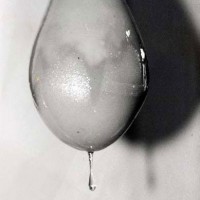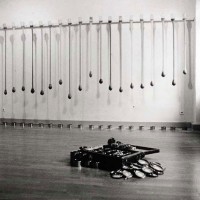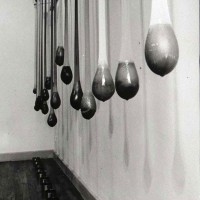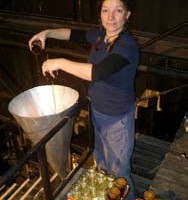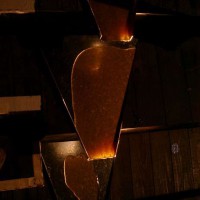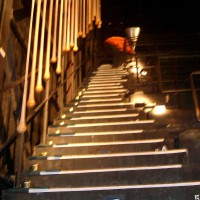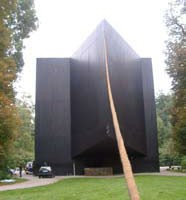Alles fliesst (alles ist uberflussig)
Materials:
Honey, silk, tins, seeds, timber, steel, glass.
Concept:
Alles fliesst (alles ist uberflussig) combines the simple elements of silk and honey with time and temperature. Honey has the ability to modify itself with the temperature – therefore, the warmer the weather the faster it flows. Everything is fluid; it changes shape and density but is always in motion.
Alles fliesst (alles ist uberflussig) is an exploration of food, life and reproduction. Perpetuation of life is a striving force in both fauna and flora. Instinct for survival produces ever-evolving strategies for continuation of the species, seed propagation, and sperm production. Strange activities – such as the collection of blue objects by bowerbirds; the exotic dances of many creatures; or the production of tasty fruit on trees; bright coloured berries and scented flowers – in humankind have evolved into highly ritualized, aesthetic[ized], even fetish[ized] behaviours.
The elements of the installation are infused with meaning. Honey is renowned for its healing properties. Local honey is believed to provide natural protection from potential allergies as the bees will have collected pollen from amphipilous plants of the area, meaning ones that are pollinated by insects and wind, and so small amounts of each species pollen will be present in the honey. Therefore when local honey is eaten it acts as an immune booster. Honey was a popular drug of the Egyptians who gathered it from wild bees; it was mixed with oil to use as a salve. Honey is harmless to tissues, yet is aseptic, antiseptic and antibiotic and hence anti-bacterial because it is extremely hypertonic – it draws water from bacterial cells – causing them to die. It is so effective that an offering of honey that was buried in a sacred chamber in Paestum over 2500 years ago has not decayed to this day.7 Honey is a stable and symbolic medium in this sense and fills the exhibition space with a sweet fragrant aroma.
Ever so slowly over the exhibition period, ten litres of golden honey transferred from inverted glass jars mounted high on the gallery wall down through the fleshy tones of twenty silk stockings, into golden metal tins below. Honey is a sweet high-energy food, and when combined with silk stockings rather erotic. Silk stockings were a luxurious gift for women, particularly during World War two, because of their scarcity. The bombing of Pearl Harbour stopped the flow of Japanese silk and nylon, which was directed into the production of parachutes.
A wooden suitcase in the exhibition space is overflowing with potential life, thirty golden tins, each filled with a different seed variety are identified with small handwritten labels. The artist collected the seeds – remnants of meals and gathered from the surrounding woodlands – over a six-month period prior to the exhibition.
The exhibition was expanded to install in the Kubus, an architecturally designed iconic black box theatre space in the historic Ilm Park in Weimar. Twentythree honey drippers ran down the sidewall of a steep staircase that led to high-tiered seating above the triangular stage. On the opposite side of the stairs, at the very top and back of the theatre, a thirty litre conical vat of honey was suspended and slowly drained over the period of the exhibition. A slow motion golden cascade of honey flowed down across the tiered seating directed by a series of aluminium trays that were lit from beneath, which made the honey glow in the darkened theatre space and acted to warm the honey to release its sweet scent into the air.
In the context of this exhibition called ‘Weimar Schwimmt’ (trans: Weimar swims) the exhibition space (the ‘Kubus’) metaphorically becomes a ship and the honey and stockings – in their ambivalent reference to two desires of seamen on long voyages, food and the opposite sex – hypostatize sustenance and survival.
Exhibition:
Courdray Haus, Bad Berka, Germany. February 2004.
‘Weimar Schwimmt’, Ag Tiefseh, The Kubus in Ilm Park Weimar, 27th September – 4th October 2003.
Publications:
SEDLACEAK, I. (2004) Alles fließt, ist in Bewegung. Algemeiner Anzeiger 25th Feb. ed. Weimar / Apolda. P. 3.
SEDLACEAK, I. (2004) Alles Fleißt – von Seide bis Honig. Thüringer Allgemeine. 12th Feb. ed. Weimar. P. 2.
(2003) Untergang des Kubus. Thüringer Allgemeine. 12th Sep. ed. Germany. P. 9.
MARGON, S. (2003) Die MS Kubus läuft von Stapel. Thüringer Allgemeine. 29th Sep. ed. Weimar. P. 2.
Thanks:
- Felix Ruffert
- Christiane Wendel
- Claudia Humboldt
- Nina Lundström
Endnotes:
7. MAJNO, G. (1975) The Healing Hand, Man and Wound in the Ancient World. The Healing Hand, Man and Wound in the Ancient World. Cambridge, Massachusetts, Harvard University Press. P. 115 – 18.
